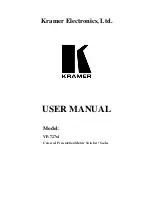
User’s Manual: SW-10200
26
9. SPANNING TREE PROTOCOL
The Spanning Tree protocol can be used to detect and disable network loops, and to provide backup links
between switches, bridges or routers. This allows the switch to interact with other bridging devices in your network
to ensure that only one route exists between any two stations on the network, and provide backup links which
automatically take over when a primary link goes down.
The Protocol allows for the blocking of links between switches that form loops within the network. When
multiple links between switches are detected, a primary link is established. Duplicated links are blocked from use
and become standby links. The protocol allows for the duplicate links to be used in the event of a failure of the
primary link. Once the Spanning Tree Protocol is configured and enabled, primary links are established and
duplicated links are blocked automatically. The reactivation of the blocked links (at the time of a primary link failure)
is also accomplished automatically without operator intervention.
To access Spanning Tree options, click on the link
Spanning Tree
in the navigation pane of the web interface.
Figure 30 - Set options for the bridge in STP
Bridge Priority: This parameter configures the spanning tree priority globally for this switch. The device with
the highest priority becomes the STP root device. If all devices have the same priority, the device with the
lowest MAC address will then become the root device. A number selected should be between
0
and
61440
in increments of 4096.
Hello Time: Interval (in seconds) at which the root device transmits a configuration message (BPDU frame).
Select a number between
1
and
10
(default is
2
).
Max Age
– The maximum time (in seconds) a device can wait without receiving a configuration message
before attempting to reconfigure. That also means the maximum life time for a BPDU frame. Select a number
between
6
and
40
(default is
20
).
Forward Delay: The maximum time (in seconds) the root device will wait before changing states (i.e.,
discarding to learning to forwarding). Choose a number from
4
to
30
(default is
15
).
Click
Submit
to save your changes. STP status is summarized in the table at the bottom of the screen.
















































